
MARS WATER TERRACES LIFE
Report #171
October 18, 2009
The evidence here is going to be from the huge MRO HiRise ESP_012625_1720 JP2 image. Regardless of its JP2 huge file size at 169.8 MB, the evidence will be fuzzy in the closer views. It's the best I could do with it. As this reporting unfolds, you'll perhaps begin to suspect why there are resolution problems in this image. Even so, it is good enough to understand the basics of what is going on here and I think you'll find it sufficiently interesting.
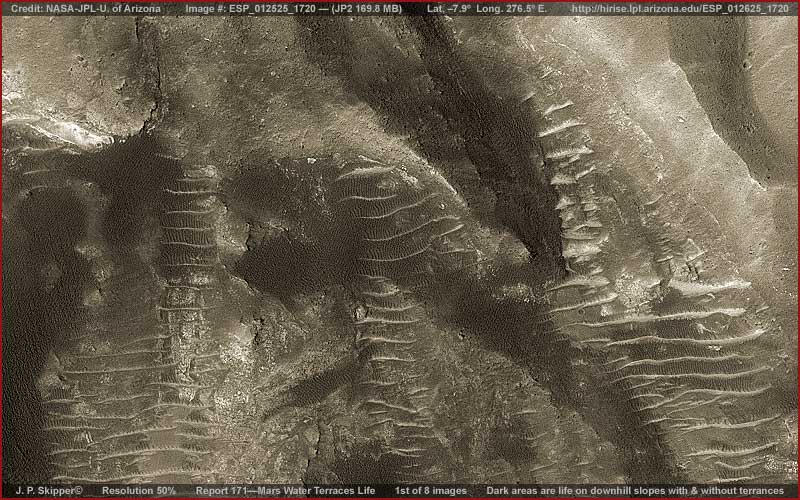
The above first image offers a
wide-angle context view of a portion of the original image that the evidence
here comes from. The darker areas you see in the above image are variations
of the "Ridge Form" life I have reported on before. Please note
that some are occupying terrain with the light color horizontal thin ridge
structures like levels of mushrooms on an old tree trunk. On the other hand,
others are just occupying large patches of terrain without the horizontal
ridge levels.
Let me give you some background information that is very important to understanding
what is going on here. This site is within Ius Chasma
which is a large steep sided canyon on the southern side of Valles Marineris
the largest canyon system in the solar system otherwise known as the Mars
great crack. Now Valles Marineris is as deep as 8–10 km or 5–6
miles and that compares to Earth Grand Canyon here in the US of only 1.6 km
or 1 mile deep. In other words, in places Valles Marineris is 5–6 times
deeper than the Grand Canyon. That's quite a hole in the ground and such a
hole guarantees steep slopes on its sides.
When you are looking at the above first image, north and up is in the top
of the image and south and down into the Ius Chasma is in the bottom of the
image. This orientation is the same and consistent with all of the images
in this report. That is important because in these images, although it may
not be visually readily apparent, you will always be looking at slopes that
may be from mild in places to very steep in other places in a single image
in this rough rocky down sloping terrain.
As I have reported before, Ridge Form life flourishes best in shallow flowing
water and is a Mars life that is dependent on that condition. They are cooperative
sharing life and orient cooperatively in rows parallel with the water flow.
So, even though the water is too shallow and thin to be seen in this distant
satellite imaging, you know the water flow is there and its direction by the
orientation of the Ridge Forms. Any intelligence is an unknown factor.
Note the darker ridge forms and the row orientation of up/down between the
light color equally spaced horizontal ridge layers. These equally spaced layers
are terraces no doubt designed to retard water which tends to be too substantial
in the steeper slope areas and might otherwise be a waterfall. Since the interval
space between the terraced ridge levels in relatively short, note that the
darker ridge form life can orient as usual in rows parallel to the water flow.
However, in those patch areas where this rough terrain isn't as steep, note
that the darker ridge forms collect into density without the implementation
of the terraces solution to retard water flow. Rather, if you will look closely
in the above image and the closer views below, you will see that there is
often still a need to retard the water flow and this is accomplished by darker
ridge forms forming a tangle or convoluted maze in their orientations. This
of course effectively retards water flow by design.
The point of this reporting is that what ever form of water dependent life
this is, it can develop creative design solutions to solving its problems
on these steep Chasma slopes. However, planetary geologists working with this
space exploration imaging will no doubt tell us that ancient long gone water
erosion going down these steep Chasma slopes carved out these formations from
layered geological material leaving harder material projecting out and softer
material eroded inward. That may sound a little plausible to you? If so, all
I can say is look closely at the evidence in the following images and judge
for yourself.
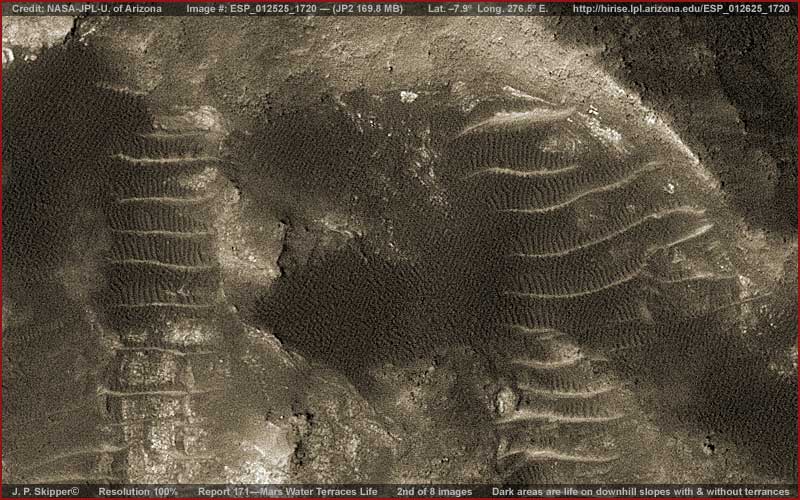

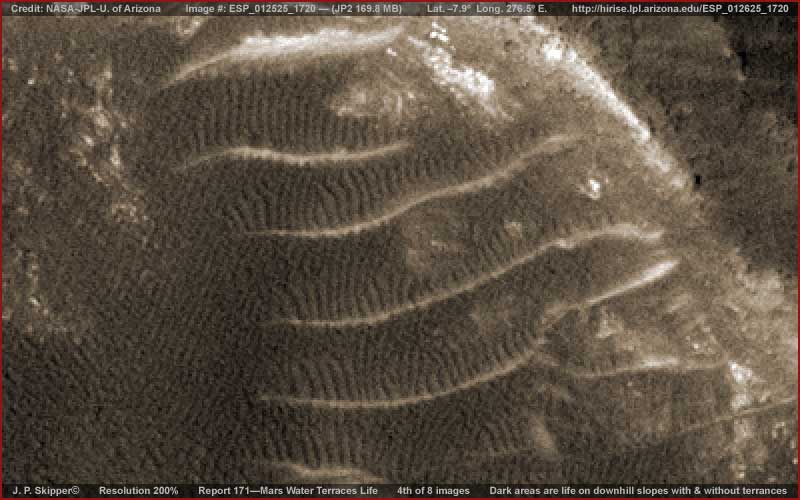
In the above 2nd, 3rd and 4th images,
note how the darker ridge forms on the equally spaced terraces always tend
to be in parallel rows while those without the terraces tend to be more maze
like in their configurations. Although blurry, note the uniformity of the
darker color evidence. So is this chance geological erosion of layer terrain
material or intelligent design typifying life?
Not quite sure what to think? Well the 5th, 6th and 7th images below demonstrate
another nearby different section of terrain in this same image strip. Note
that here there is an up and down oriented elongated depression precisely
filled much more pronounced huge terraces that even have the visual impression
of being cantilevered to some degree with some appearing to cast shadows on
the terrace below that they overhang. Note that the upper surface of each
largest terrace is always densely packed with something upright and in high
density.
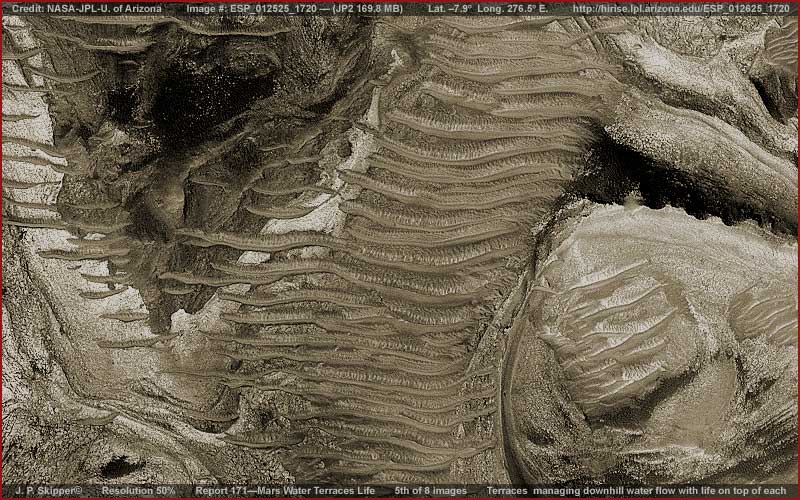
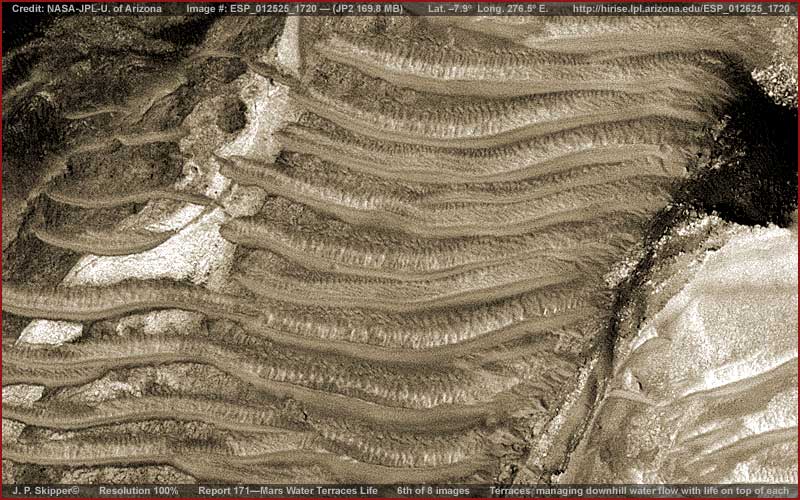
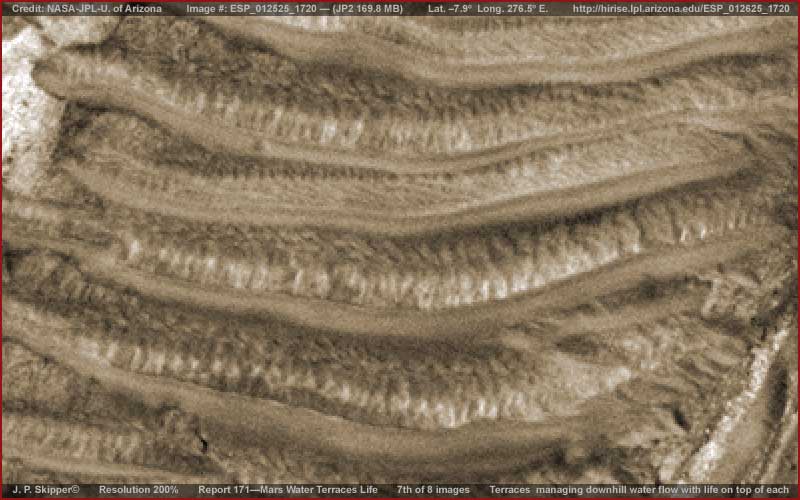
Unfortunately, the blurry resolution
of the original doesn't allow us a better look at the smaller upright densely
packed evidence on the top side of each terrace. So we can't determine, for
example, if these might be upright structures like dwellings or some giant
life form developing multiple layers along the depression water flow route
like some form of mushroom colony life with the upright structures acting
as filters. On the other hand, for me it is a clear indication of life of
some kind and not inanimate geology.
There is just too much uniformity from level to level consistent with adaptive
life of the some unknown kind here as opposed to chance geological erosion.
However, either way, such analysis is based on the presence of water either
currently enabling life or in ancient times eroding geological layers. So,
if life is to be considered, is there any evidence of current surface water
in this location? As it turns out, there is and the next and last image below
defines it.
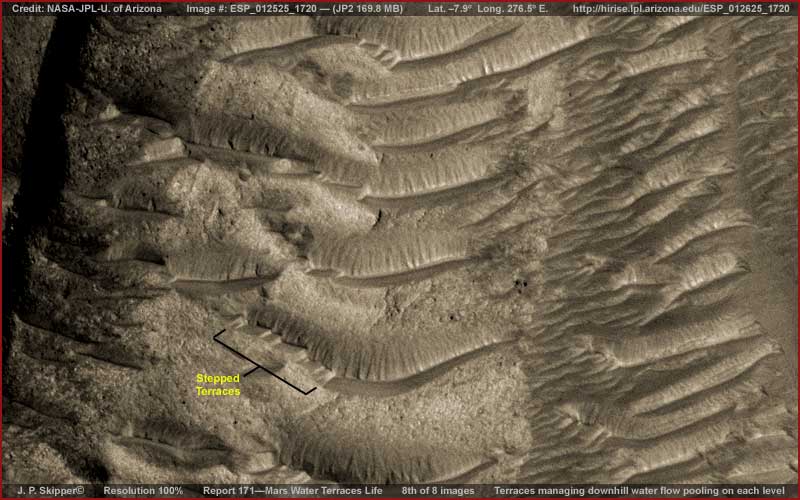
The above eighth image demonstrates
the presence of surface water very nearby in the same image strip. What you're
looking at is a shallow depression with crisscrossing forms in it and shallow
water among those terracing forms. Water comes into this up and down oriented
depression mostly from the water flow eroded land forms on the right and works
its way down through and around these terracing forms.
Note that I have pointed out some smaller stepped terraces labeled with yellow
text. On this particular terrace, water from the terrace above obviously flows
around the left end and then back to the right down the steps I've pointed
out that slow the water flow. These are the most visually obvious of such
steps in this image but there are others if you will look close.
I have no idea whether these terraces are purely land forms that they look
like here or whether they represent the beginnings of the same type of mature
terraces we see in the 5th, 6th and 7th images? At this point I'm not concerned
with that question so much as I am that this is evidence of current water
presence in this same image with all the implications that this has for enabling
life.
Obviously surface water is consistently flowing down these Chasma slopes and
with canyons in the great crack being as much as 8-10 km or 5-6 miles deep,
regardless of any prejudices about Mars dry conditions, this is to be expected
and should come as no surprise. The real surprise would be if there was no
water at all coming down these slopes. Where there is water there is life
and life usually finds a way, especially when it has time to adapt.
You see, these things, although they may seem a bit strange to some at first
blush due to unfamiliarity, do not require rocket science mental acuity, only
decent eyesight and some common sense unfettered by close mindedness. For
the most part, things are impossible only in the psychology of perception
while the real world moves on doing its thing.
DOCUMENTATION
http://hirise.lpl.arizona.edu/ESP_012625_1720:
This links takes you to the official MRO HiRise ESP_012625_1720
science data image. Note that I developed this report's evidence from the
JP2 169.8 MB image which requires the free IAS Viewer and you'll have to use
that to get the same quality results.
, Investigator
![]()